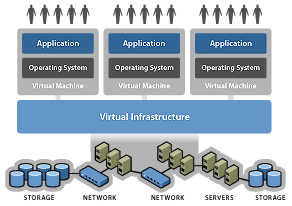Virtual Infrastructure in Manufacturing Produces Strong ROI When Implemented Properly
December 2, 2012

By: James Burnand, Director – Mid-Atlantic Region, Grantek Systems Integration
It may feel as though virtualization has burst into the scene for some in the manufacturing industry. While the technology might be new to some in manufacturing, it has been through many generations of maturity in the Enterprise IT space. Virtualization pays huge dividends for manufacturing systems when it is implemented correctly.
So, What is a Virtual Infrastructure?
I define it as: The collection of virtual computing capability necessary for your business. Further, I consider the core service applications that are required as part of a manufacturing environment included within the definition of computing capability. To define this within manufacturing, first you must consider what a plant might look like from a computing perspective and attempt to frame an approximate virtual computing capability.
For obvious reasons, this gets complicated. Some manufacturers are not aware of the benefits of service applications and have no plans to include them in their facilities. Others take an application by application approach to servers and never consider computing as a resource. The analogy I love to use is this:
If you were to build a new house, would you choose to buy an air conditioner and space heater for each room (traditional application/server) or would you size mechanical services for the entire house?
The same mentality should be used for service applications. You need to size something that is appropriate for your computing capability needs.
Typical Manufacturing Virtual Infrastructure Implementation
A typical Manufacturing Virtual Infrastructure in a facility would include the following types of applications:
|
|
The life cycle of equipment in the manufacturing space is typically 10+ years, yet computing life cycles are closer to 3 years. Since these application software packages are often required to function beyond the designed lifetime of the hardware, the use of a virtual platform can allow for the seamless migration to new hardware, once its life cycle is complete.
Things to consider when implementing a virtual infrastructure in manufacturing:
- When deciding on your computing infrastructure, think about your entire business – don’t buy individual window air conditioners!
- Use standard IT life cycles for computing equipment so you’re sure to always have your platform under OEM support.
- Think about the different capabilities of virtualization technologies and align to your availability needs.
- Consider the availability needs of your systems and identify the available options to achieve those requirements.
- Use a partner that is qualified and certified in your technology of choice.
- Create a roadmap of your future state of computing and work towards it with each project.
- Don’t forget about your network. It’s CRUCIAL to the success of your virtual infrastructure.
- Ensure you have the right support for the platform and the applications living within it.
